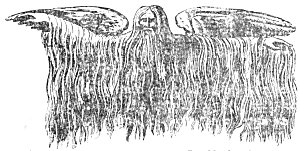In the Mysteries of Isis, the candidate first passed through the
p. 404
dark valley of the shadow of death; then into a place representing the elements or sublunary world, where the two principles clash and contend; and was finally admitted to a luminous region, where the sun, with his most brilliant light, put to rout the shades of night. Then he himself put on the costume of the Sun-God, or the Visible Source of Ethereal Light, in whose Mysteries he was initiated; and passed from the empire of darkness to that of light. After having set his feet on the threshold of the palace of Pluto, he ascended to the Empyrean, to the bosom of the Eternal Principle of Light of the Universe, from which all souls and intelligences emanate.
Plutarch admits that this theory of two Principles was the basis of all the Mysteries, and consecrated in the religious ceremonies and Mysteries of Greece. Osiris and Typhon, Ormuzd and Ahriman, Bacchus and the Titans and Giants, all represented these principles. Phanes, the luminous God that issued from the Sacred Egg, and Night, bore the sceptres in the Mysteries of the New Bacchus. Night and Day were two of the eight Gods adored in the Mysteries of Osiris. The sojourn of Proserpine and also of Adonis, during six months of each year in the upper world, abode of light, and six months in the lower or abode of darkness, allegorically represented the same division of the Universe.
The connection of the different initiations with the Equinoxes which separate the Empire of the Nights from that of the Days, and fix the moment when one of these principles begins to prevail over the other, shows that the Mysteries referred to the continual contest between the two principles of light and darkness, each alternately victor and vanquished. The very object proposed by them shows that their basis was the theory of the two principles and their relations with the soul. “We celebrate the august Mysteries of Ceres and Proserpine,” says the Emperor Julian, “at the Autumnal Equinox, to obtain of the Gods that the soul may not experience the malignant action of the Power of Darkness that is then about to have sway and rule in Nature.” Sallust the Philosopher makes almost the same remark as to the relations of the soul with the periodical march of light and darkness, during an annual revolution; and assures us that the mysterious festivals of Greece related to the same. And in all the explanations given by Macrobius of the Sacred Fables in regard to the Sun, adored under the names of Osiris, Horus, Adonis, Atys, Bacchus, etc., we
p. 405
invariably see that they refer to the theory of the two Principles, Light and Darkness, and the triumphs gained by one over the other. In April was celebrated the first triumph obtained by the light of day over the length of the nights; and the ceremonies of mourning and rejoicing had, Macrobius says, as their object, the vicissitudes of the annual administration of the world.
This brings us naturally to the tragic portion of these religious scenes, and to the allegorical history of the different adventures of the Principle, Light, victor and vanquished by turns, in the combats waged with Darkness during each annual period. Here we reach the most mysterious part of the ancient initiations, and that most interesting to the Mason who laments the death of his Grand Master Khir-Om. Over it Herodotus throws the august veil of mystery and silence. Speaking of the Temple of Minerva, or of that Isis who was styled the Mother of the Sun-God, and whose Mysteries were termed Isiac, at Sais, he speaks of a Tomb in the Temple, in the rear of the Chapel and against the wall; and says, “It is the tomb of a man, whose name respect requires me to conceal. Within the Temple were great obelisks of stone [phalli], and a circular lake paved with stones and revetted with a parapet. It seemed to me as large as that at Delos” [where the Mysteries of Apollo were celebrated]. “In this lake the Egyptians celebrate, during the night, what they style the Mysteries, in which are represented the sufferings of the God of whom I have spoken above.” This God was Osiris, put to death by Typhon, and who descended to the Shades and was restored to life; of which he had spoken before.

Moe is the founder of GnosticWarrior.com. He is a father, husband, author, martial arts black belt, and an expert in Gnosticism, the occult, and esotericism.





